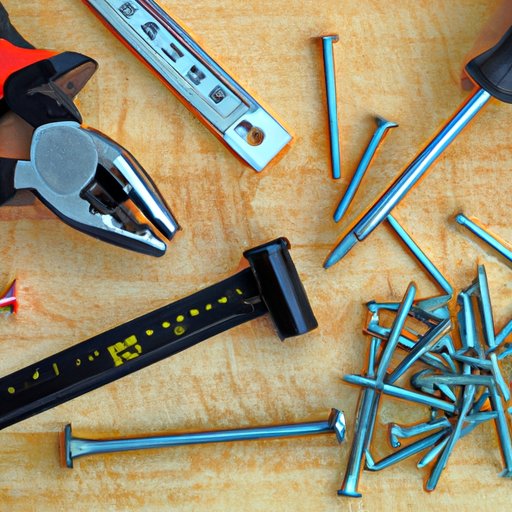
I. Introduction
Stripped screws are a common problem that can turn even a simple DIY project into a frustrating nightmare. Maybe you’re trying to install a new light fixture or build some furniture, but you just can’t get the stripped screw out. Don’t worry, we’ve all been there. The good news is, there are several reliable methods to get out stripped screws. In this article, we’ll cover six methods that can help you save time and avoid additional frustration.
II. Using a Rubber Band
One of the simplest and easiest ways to get out stripped screws is by using a rubber band. Here’s how to do it:
- Take a rubber band and wrap it around the head of the stripped screw.
- Using a screwdriver, insert the tip into the screw head, firmly pushing down so that the rubber band fills in any gaps between the screw and the driver.
- Slowly turn to remove the screw.
If the rubber band slips off, try using a thicker or wider band. You can also try heating the screw head with a hairdryer or heat gun to make the rubber band more pliable and easy to grip.
III. Trying Pliers
If the rubber band method didn’t work, another reliable method is using pliers to grip the stripped screw head. Here’s how:
- Choose a pair of pliers with a good grip and a sharp, pointed tip.
- Using the pliers, grip the sides of the screw head as tightly as possible.
- Slowly turn to remove the screw.
Be careful not to apply too much pressure, as this can damage the screw and make it even more difficult to remove. If the screw is still stuck, you can try tapping the pliers gently with a hammer to loosen it up.
IV. Applying Heat
Heat can also be used to remove stripped screws. Here’s how:
- Choose a heat source such as a hairdryer, heat gun, or soldering iron.
- Apply heat to the screw head for 30 seconds to 1 minute. This will cause the metal to expand slightly and loosen the screw.
- Using a screwdriver, slowly turn to remove the screw while it’s still hot.
Be careful not to burn yourself when using heat sources. Wear gloves and be mindful of where you direct the heat. This method is especially effective when used in combination with other methods like pliers or a screw extractor.
V. Using a Screw Extractor
If the stripped screw is particularly stubborn, a screw extractor is a reliable tool that can get the job done. Here’s how to use one:
- Using a drill, make a small hole in the center of the stripped screw head.
- Insert the screw extractor into the hole and turn counterclockwise until it grips the screw firmly.
- Using a wrench, turn the screw extractor and remove the screw.
Be sure to choose the right size extractor for the screw you’re removing. A screw extractor is a great investment for those who frequently encounter stripped screws.
VI. Using a Hammer and Screwdriver
Another effective method is to use a hammer and screwdriver. Here’s how:
- Choose a screwdriver with a good grip that fits snuggly into the stripped screw head.
- Tap the end of the screwdriver gently with a hammer to loosen the screw.
- Using the screwdriver, turn to remove the screw.
Be very careful when using this method, as too much force can damage the screw and surrounding area. It’s important to tap gently and use a screwdriver with a good grip.
VII. Cutting a Notch
If all else fails, cutting a notch in the screw head can provide enough grip to remove it with a flathead screwdriver. Here’s how to do it:
- Using a rotary tool or hacksaw, make a small notch in the center of the screw head.
- Insert a flathead screwdriver into the notch and turn to remove the screw.
This method requires precision and care. Be sure to use a rotary tool or hacksaw with a high level of control and accuracy.
VIII. Conclusion
Encountering stripped screws can be a frustrating experience, but with these six reliable methods, you’ll be able to tackle any project with confidence. While not every method will work for every screw, it’s important to try them in combination or experiment with them to determine what works best for you. As always, be sure to take safety precautions when using any tools or heat sources, and don’t hesitate to seek professional help if you encounter any difficulties or are unsure about how to proceed.





